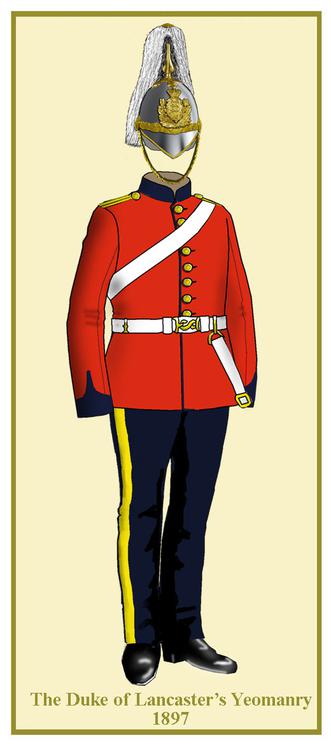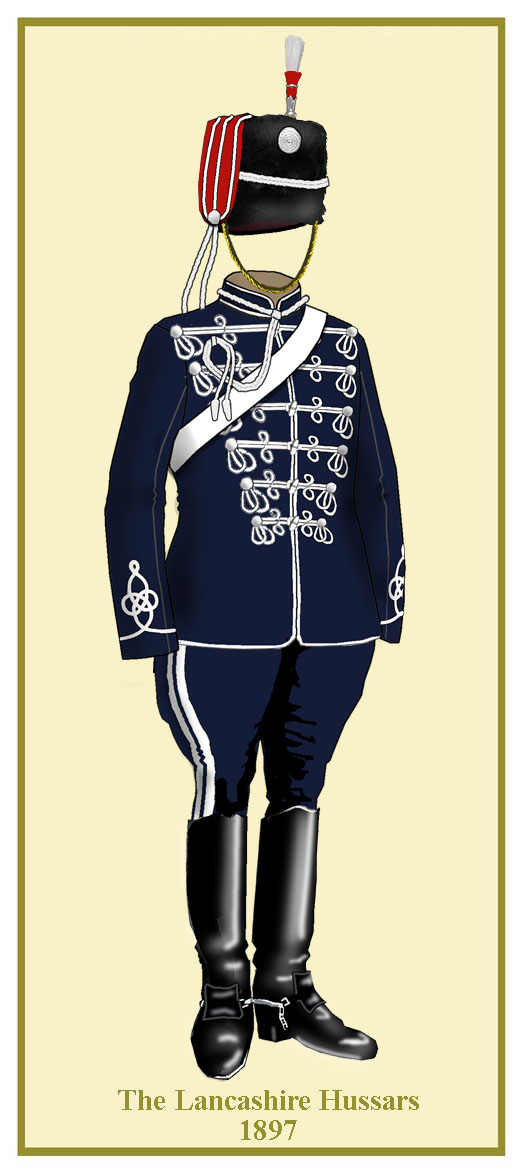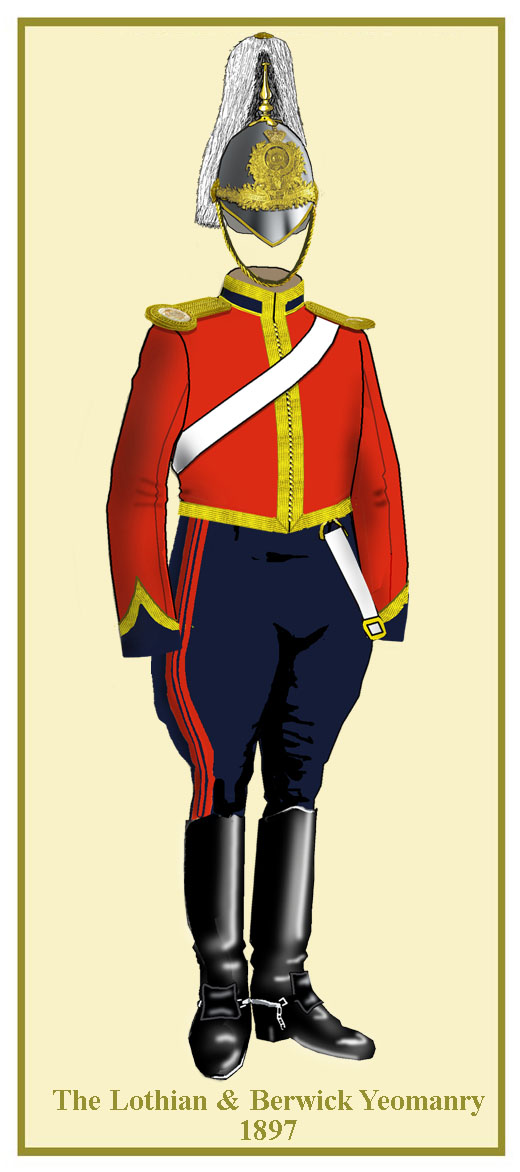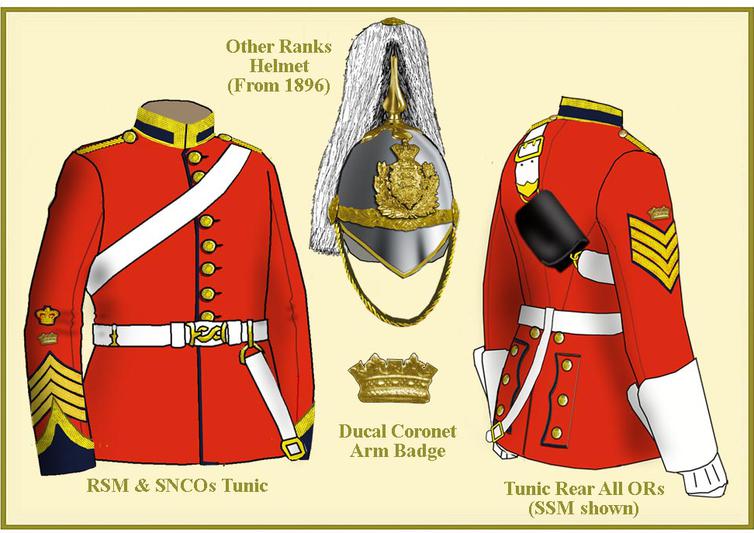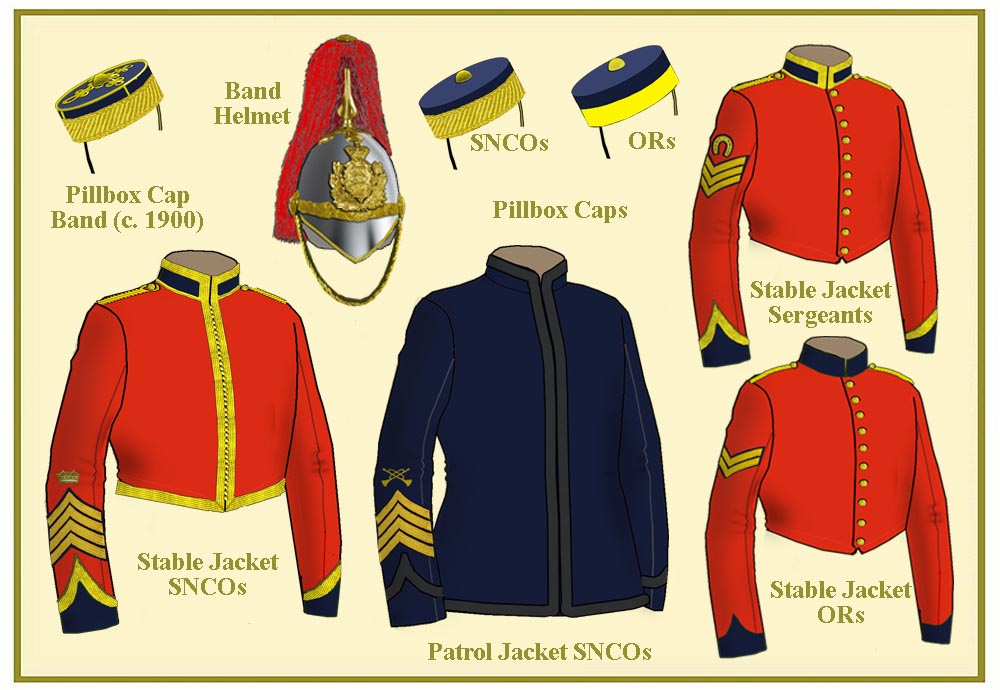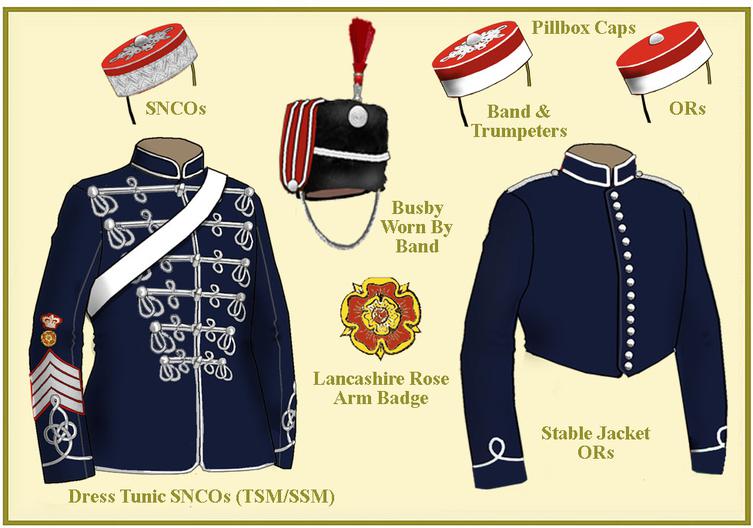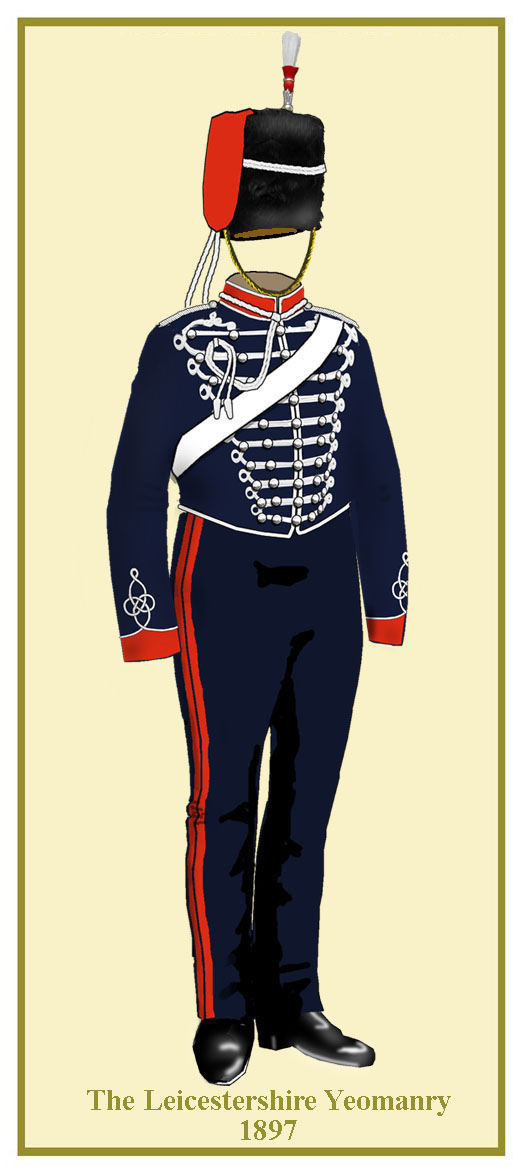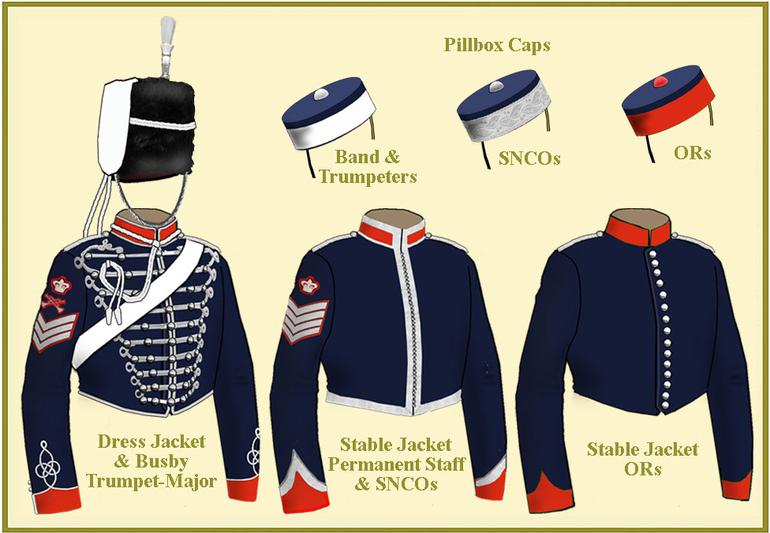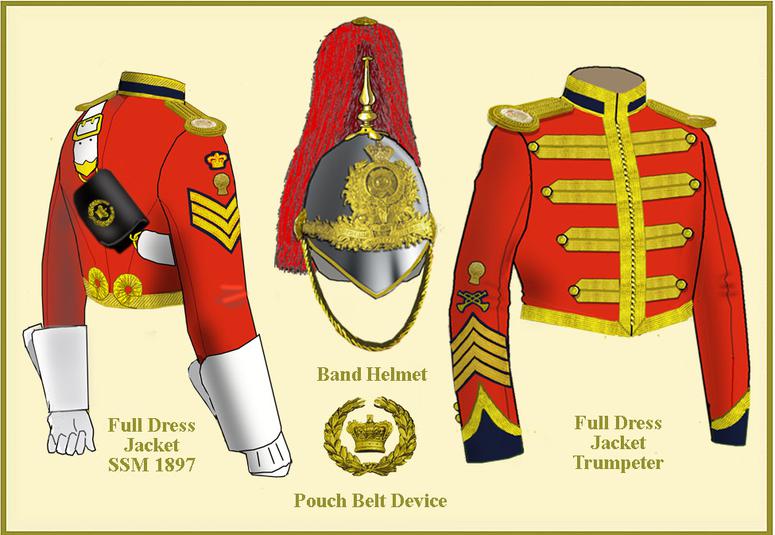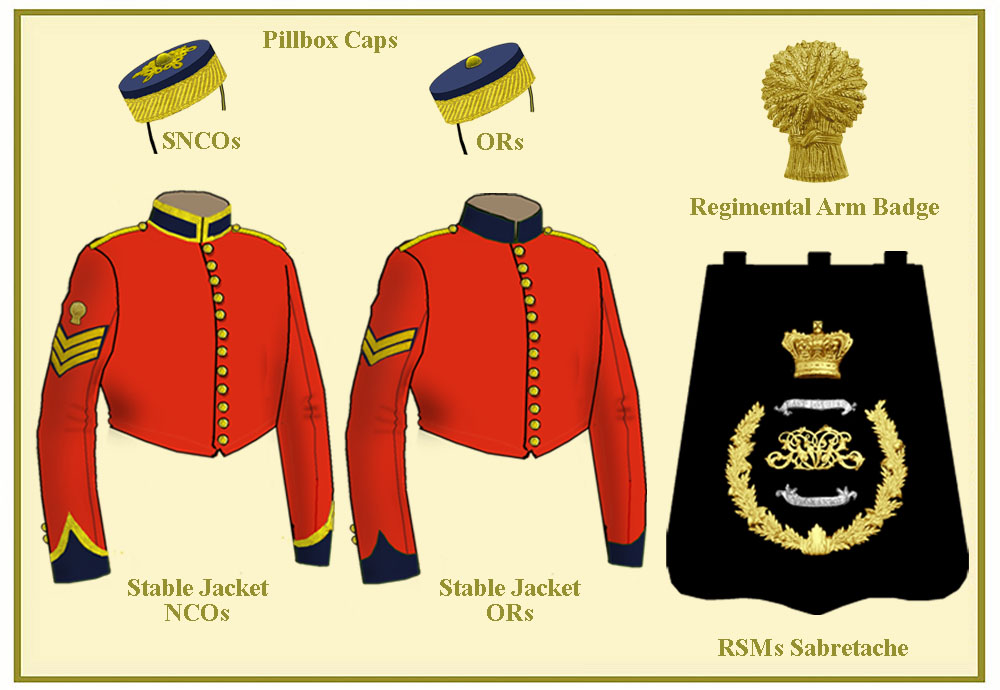The Duke of Lancaster's Own Yeomanry
Ranked No. 12 in Yeomanry Order of preference
In 1798 a troop of yeomanry was formed in Bolton and remained in service until 1819. A troop was raised in Furness that same year and by 1828 had been joined by a newly raised Bolton troop and one from Wigan to form the Lancashire Yeomanry Cavalry. In 1834, in honour of their royal patron, the Sovereign William IV, they were renamed the Duke of Lancaster’s Own Yeomanry.
Formed 23rd Coy of 8th Bn Imperial Yeomanry in 1900
UNIFORMS OF THE BRITISH YEOMANRY REGIMENTS 1895-1900
PART 5
Uniforms
Physical evidence of the uniforms worn before 1820 is not available. Willson’s volunteer chart show the Ashton and Bolton troops in blue with red facings while the Manchester troops are in scarlet with blue. In all probability they wore the Tarleton helmet or round hats with plumes. In 1820the Bolton troop was dressed as light dragoons with blue coatee with white facings and lapels with black bell topped shako all laced gold. The Furness troop at the same time apparently were dressed as cuirassiers (although the wearing of cuirasses has never been confirmed). In 134 the now united Duke of Lancaster’s Yeomanry were dressed as Dragoons with scarlet coatee with blue collar and cuffs, black japanned helmet with brass rayed plate and black fur crest. After the Crimean War a double-breasted scarlet tunic and 1847 pattern Albert helmet was taken into wear. The helmet was black leather and the plume and brush were white. The tunic became single breasted in 1863 and the helmet changed to black japanned metal. The tunic was cut the same way as the heavy cavalry version in the regular army. The main difference was plain pointed blue cuffs and collar. The tunic was piped blue down the front as were the three pointed flaps on the rear skirts. The trousers were blue with 1.75” yellow stripes. Pantaloons and knee boots were introduced for other ranks in 1888. In 1896 the helmet was replaced with the 1871 pattern white metal helmet with white plume.
The RSM, Quartermaster and most SSMs had a half inch band of lace round the collar and above the cuffs. Before the change from troops to squadrons, TSMs had lace on the collar only. There is actually some confusion about when or if changes were made. In undress, scarlet stable jackets were worn, with plain blue collar and cuffs with SNCOs having lace down the front, on the collar and on the cuffs. Pill box caps were blue with yellow bands for ORs and gold for sergeants on up. The RSM, QM and Bandmaster wore blue patrol jackets with black edging and falling loops like officers while SSMs and the Trumpet-Major wore a plain blue jacket with black mohair edging. The ducal crown as an arm badge came into wear sometime before 1876 and was worn by all ranks above sergeant and in the case of SNCOs in place of the QV crown. White gauntlets were worn in review order.
The Lancashire Hussars
Ranked No. 38 in Yeomanry Order of preference
A unit of Yeomanry was raised at Ashton in 1798 which existed until 1828. Its remaining members joined the Lancashire Yeomanry Cavalry in 1828. In 1848 a new regiment was formed mostly from members of the Ashton troop (who were predominantly Roman Catholic). They quickly styled themselves The Lancashire Hussars.
Formed 32nd Coy of 2nd Bn & 77th Coy & part of 23rd Coy of the 8th Bn Imperial Yeomanry in 1900
The Leicestershire Yeomanry (Prince Albert's Own)
Ranked No. 10 in Yeomanry Order of preference
A regiment of six troops was raised at the Three Crowns Inn in Leicester in 1794 and disbanded in 1802. The following year on the resumption of the war, the regiment was raised once more. While many of the yeomanry corps were disbanded in the late 1820s , the Leicestershire Yeomanry Cavalry remained in existence. After escorting Queen Victoria and her consort in 1843, the Leicestershire Regiment of Yeomanry Cavalry was designated “The Prince Albert’s Own.” by the Queen (17th Feb 1844). On presentation of the new Standards/Guidons in 1844 the title was proudly displayed thereon and is used to the present day.
Formed 7th Coy of 4th Bn Imperial Yeomanry 1900 and the 65th Coy of the 17th Bn 1901.
The Lothian and Berwickshire Yeomanry
Ranked No. 36 in Yeomanry Order of preference
Raised in 1797, the regiment comprised five troops among which were the "East Lothian Yeomanry Cavalry" and the "Berwickshire Yeomanry". After several disbandments and re-risings, "The East Lothian and Berwickshire Yeomanry Cavalry" was formed in 1880 and became "The East Lothian and Berwickshire Imperial Yeomanry" in 1900.
Formed 19th Coy of 6th Bn Imperial Yeomanry in 1900
The band had scarlet plumes on their helmets and in undress from the late 1890s a blue pillbox with gold lace band, figuring on the crown and lancer quarterings.
In 1903 the regiment put its old tunics into store and adopted a smart scarlet four pocket serge frock with shoulder chains, blue collar and pointed cuffs. There was a brass rose on the collar. The peaked staff pattern cap was blue. The khaki undress was plain with only scarlet piping on the breeches. A plain khaki slouch hat was worn with blue puggaree. At the 1911 coronation the regiment wore the smart scarlet frock, yellow striped overalls and full dress helmet.
Uniforms
When the Lancashire Hussars were raised they were dressed magnificently as hussars with braided jackets, pelisses and scarlet Albert pattern shakos. The officers wore scarlet overalls while other ranks wore blue. All lace was gold for officers and yellow for men. In 1861 the shakos were replaced by busbies with scarlet bags for all ranks and the pelisses were withdrawn. The officers also reseved the scarlet overalls for levees only.
When the order came down from Horse Guards in 1877 that all gold lace for Yeomanry regiments should be changed to silver, the Lancashire Hussars made the change in 1879, unlike other regiments who came up with excuses (usually based on cost) to keep the gold lace.
The new uniform was based on the regular hussar dress with six loops across the front of the tunic and no facings on collar or cuffs. The busby adopted was the 1857 pattern with white cords, boss and a crimson bag also laced white with a white above crimson plume. The overalls had double white stripes as did the pantaloons introduced in 1885 along with knee boots with V cut. The RSM, Permanent Staff Sergeants and Trumpet-major had silver lace instead of white on busby and tunic. The band wore a completely crimson plume.
All rank badges were silver on crimson backing and the Lancashire rose in gold with crimson petals was worn as an arm badge for NCOs above the rank of corporal. The RSM had a plain black sabretache with a silver rose and crown above.
The stable jacket was plain blue for other ranks with white piping on collar and cuffs. SNCOs had silver piping around the edges and silver loops on the cuffs. The pill box was crimson with a white band for ORs and silver for NCOs. The band had an additional white lace figuring on the crown.
After the Boer War the Lancashire Hussars wore a khaki drab tunic laced exactly as the hussar tunic in white. The collar and cuffs were crimson and the slouch hat had a brown leather band. NCOs still wore silver chevrons on crimson backing. Later the regiment adopted a crimson staff pattern cap with silver badge. The blue frock had crimson collar and cuffs and shoulder chains. This was the uniform worn at the 1911 coronation.
Uniforms
From their raising in 1794, the Leicestershire Yeomanry wore scarlet with blue facings. At first it was a coatee with blue lapels and black round hat with black fur crest and white over red plume. In about 1808 the Tarleton helmet with black crest and scarlet turban with white over red plumewas worn and the jacket had three vertical rows of buttons. The blue cuffs were pointed, the lace was silver and the trousers were light blue with white stripes. By 1841, the Leicestershire Yeomanry Cavalry was one of the few remaining units wearing the Tarleton helmet although the jacket now had two rows of buttons in the contemporary style. In 1843 a black bell topped shako with white/silver lace was adopted. The drooping plume was white and overalls were dark blue. After the Crimean War, the regiment began to dress itself in hybrid heavy dragoon/lancer style. A black japanned Albert pattern helmet with white plume was taken into wear along with a double breasted lancer tunic with dark blue collar, cuffs and turned back lapels. Black leather pouch belts were worn.
In 1870, a major change took place in the regiment’s uniform. It was decided to adopt a jacket in the style of the Royal Horse Artillery c. 1846 in blue with scarlet facings but with white lace instead of yellow. At the same time, an RHA style sealskin busby of 1857 pattern was introduced with red bag and white over red plume. By 1881 pantaloons and knee boots were taken into wear and the uniform remained largely the same until the end of the century. The Quartermaster and Trumpet-Major wore the ORs uniform with silver instead of white lace. The RSM wore the officer’s pattern jacket. All SNCOs wore silver busby lines with silver egg-moulds. The looping of busby lines varied, largely because the regiment very rarely wore the busby, which was never replaced by the 1887 pattern and wore the pillbox instead. The lines were looped on the left until 1892, then on the right. At one time 11th Hussar style pleated lines were worn. Other observations show that the loops on the ends of the chest braiding grew smaller as the eighties and nineties progressed. It also appears that overalls were discontinued in 1897 and pantaloons and knee boots were worn in most orders of dress. In undress SNCOs wore a blue stable jacket with silver edging all round as well as on the collar and cuffs while other ranks had a plain blue jacket with pointed scarlet cuffs and collar. The pill box was blue with scarlet band and NCOs had a 1.75” silver oak-leaf band. The band and trumpeters wore a white bag on their busbies with an all-white plume (larger than ORs) and a white band and button on the pill box. Blue serge jackets with patch pockets replaced the stable jackets in 1898. These had plain blue shoulder cords while the band had white twisted shoulder cords.
After 1902 the regiment wore khaki jackets with scarlet collar and shoulder straps and a scarlet piping on the pointed cuff with scarlet trefoil above. The Bedford cord pantaloons had a white stripe down the side. Khaki peaked caps were worn. The blue frock acquired shoulder chains in 1908 and a blue staff pattern peaked cap with scarlet band and piping was introduced. This cap was worn with full dress jacket and (newly restored) overalls at King George Vths coronation in 1911.
.
Uniforms
It is frustratingly difficult to describe the early uniforms of this regiment as very little documented information exists. It does however appear that when it was formed it wore a scarlet gold laced stable jacket with distinctive shoulder scales and black Albert pattern helmet. The helmet was replaced by a black leather helmet in the early 1860s. This had a white brush or feather on acanthus leafed holder or a grenade with flames instead of the brush (sounds like the 1844 Russian helmet!). By the mid eighteen seventies a black japanned Albert pattern helmet with spike was being worn. Finally, in about 1888 a white metal 1871 pattern helmet was adopted which was nominally like that of the Life Guards. It had a white horsehair plume and a new brass badge. It remained in use for the rest of the regiment’s life. The jacket remained unchanged throughout the period. Pantaloons and knee boots replaced the booted overalls at the same time as the new helmet. They were dark blue with stripes of 2nd Life Guards’ pattern, double wide scarlet stripes with a scarlet ‘light’ between. Trumpeters and bandsmen wore scarlet plumes in their helmets and their jackets were distinguished by four pointed wide strips of gold lace across the front with buttons on the points.
The regiment went into plain khaki after the Boer War but wore blue frocks for some occasions.
A blue staff pattern cap was worn. In 1908 the regiment’s name was changed to “Lothian and Border Horse” and they wore Scarlet Life Guard styled tunics with triple striped overalls at the 1911 coronation.
.
Undress consisted of a plain scarlet stable jacket with plain blue pointed cuffs and collar, both of which for NCOs were edged with gold lace. In the late 1890s a regimental arm badge of a wheatsheaf was worn above the chevrons of sergeants and above. The pill box cap was blue with gold bands and buttons for all ranks. The RSM and QM had a gold figure on the crown. All ranks wore a white pouch belt with black pouch which had a brass device of a crown within a wreath on the flap. The RSM wore an officers pattern undress black leather sabretache with a gilt device of a double reversed royal monogram with a crown above surrounded by a thistle wreath. Above and below the monogram on silver scrolls, the motto “East Lothian” on the top one and “Yeomanry” below. White gauntlets were apparently worn for the Diamond Jubilee celebrations, but white gloves were worn when doing their famous “Musical Ride” with lances.
Duke of Lancaster's Yeomanry
Lancashire Hussars
Leicestershire Yeomanry
Lothian & Berwick Yeomanry


